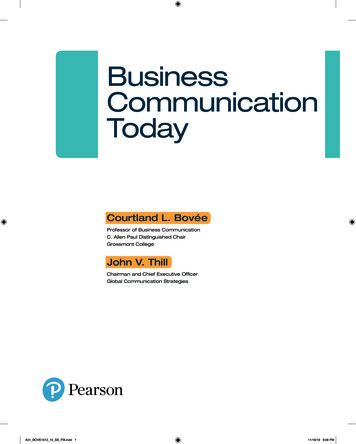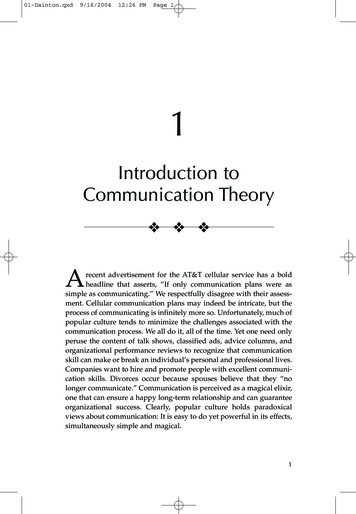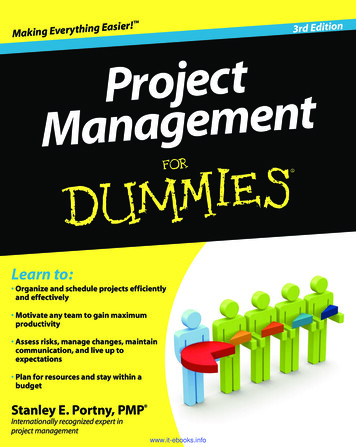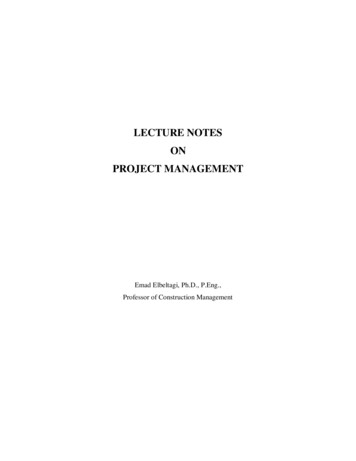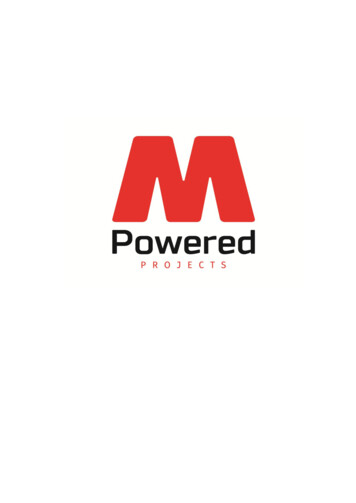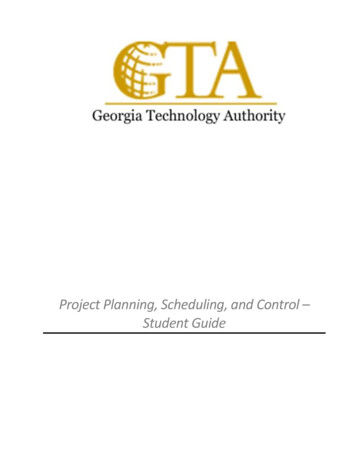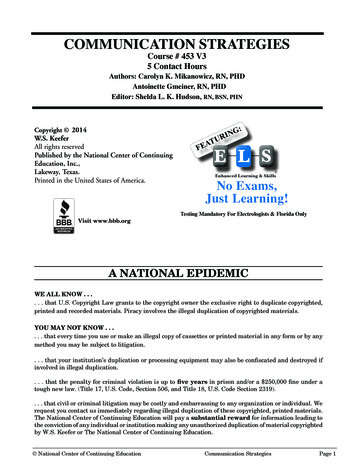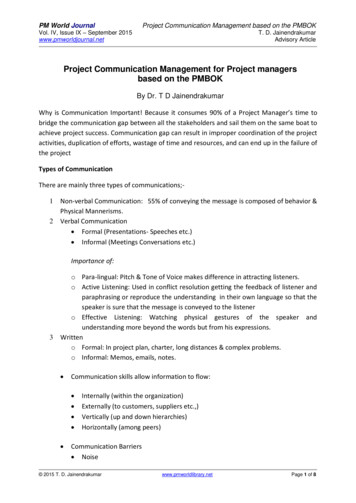
Transcription
PM World JournalProject Communication Management based on the PMBOKVol. IV, Issue IX – September 2015www.pmworldjournal.netT. D. JainendrakumarAdvisory ArticleProject Communication Management for Project managersbased on the PMBOKBy Dr. T D JainendrakumarWhy is Communication Important! Because it consumes 90% of a Project Manager’s time tobridge the communication gap between all the stakeholders and sail them on the same boat toachieve project success. Communication gap can result in improper coordination of the projectactivities, duplication of efforts, wastage of time and resources, and can end up in the failure ofthe projectTypes of CommunicationThere are mainly three types of communications;1 Non-verbal Communication: 55% of conveying the message is composed of behavior &Physical Mannerisms.2 Verbal Communication Formal (Presentations- Speeches etc.) Informal (Meetings Conversations etc.)Importance of:o Para-lingual: Pitch & Tone of Voice makes difference in attracting listeners.o Active Listening: Used in conflict resolution getting the feedback of listener andparaphrasing or reproduce the understanding in their own language so that thespeaker is sure that the message is conveyed to the listenero Effective Listening: Watching physical gestures of the speaker andunderstanding more beyond the words but from his expressions.3 Writteno Formal: In project plan, charter, long distances & complex problems.o Informal: Memos, emails, notes. Communication skills allow information to flow: Internally (within the organization)Externally (to customers, suppliers etc.,)Vertically (up and down hierarchies)Horizontally (among peers)Communication Barriers Noise 2015 T. D. Jainendrakumarwww.pmworldlibrary.netPage 1 of 8
PM World JournalProject Communication Management based on the PMBOKVol. IV, Issue IX – September 2015www.pmworldjournal.net T. D. JainendrakumarAdvisory ArticleDistanceHostilityLanguageCultureEvaluative tendencyImproper DecodingPersonality and interestPosition and statusLack of responsive feedbackWithholding informationMixed messagesStereotypingPlan Communication ManagementThis is the first process in this knowledge area which comes in planning process group fordetermining Stakeholder s’ information needs and defining communication approach: Who needs WhatWhen he/she needs itWho will deliverHow will it be delivered (report, email, verbal, etc?)This should be planned early and revised through the whole project life because impropercommunication planning will lead to significant problems.Plan Communications: Inputs1. Project Management Plan (serves as a reference for information and executing theproject as per the plan and monitoring the project to see that everything is going as perplan)2. Stakeholder ionrequirementsof3. Enterprise Environmental Factors: Company’s culture, infrastructure, market conditionsetc.4. Organizational Process Assets: Historical records- lessons learned – templatesguidelines & Procedures. 2015 T. D. Jainendrakumarwww.pmworldlibrary.netPage 2 of 8
PM World JournalProject Communication Management based on the PMBOKVol. IV, Issue IX – September 2015www.pmworldjournal.netT. D. JainendrakumarAdvisory ArticlePlan Communication Mgmt.: T & T1. Communication Requirements Analysis: Determine information needs of the projectstakeholder. Number of communications channels required for a team is calculatedusing the formula N(N-1)/2, where N is the number of stakeholders. For example ifthere are 5 stakeholders, then there must be 5(5-1)/2 10 communication channels.2. Communication Technology: affected by The urgency of the need for the information including frequency and format Expected Project staffing (experience, training, etc.) Availability of Technology (technology should be available to all the parties orstakeholders) Ease of Use by all the parties Project environment like teams are collocated or virtual and cross culturaldifferences etc. has to be considered) Sensitivity and confidentiality of information has to be identified andcommunicated appropriately.3. Communication Models.The sender encodes the message, which is transmitted through a communication channelcalled the medium of communication. There are factors like distance, cultural differences and 2015 T. D. Jainendrakumarwww.pmworldlibrary.netPage 3 of 8
PM World JournalProject Communication Management based on the PMBOKVol. IV, Issue IX – September 2015www.pmworldjournal.netT. D. JainendrakumarAdvisory Articlewhatever is disturbing the communication is called Noise. The receiver decodes the messageand understood, a feedback is sent to the sender.4. Communication Methods: Interactive (meetings, phone calls, video conferences, etc.) Push Communications (letters, memos, reports, emails, faxes, etc.) Pull communications (Intranet, knowledge repositories, etc.)5. Meetings to understand the information requirements of stake holders.Plan Communications: Outputs1. Communications Management Plan: Should include : Communications item: information for distribution Purpose: The reason of the distribution Start and end dates. Medium and formality (information distribution technology) Responsibility: who will distribute the information Escalation Procedures (In case of the absence of receiver or sender someonemust be entrusted in the organization to see that the communication is flowing,and the activities are going without interruption in the best interest of theorganization) Glossary of Terminology for clarity of information2. Project Documents Updates. (Project Schedule and Stakeholder register are updated.Manage CommunicationThis is the second process in this knowledge area which comes in execution process group forcreating, collecting, distributing, storing, retrieving, and ultimate disposition of projectinformation according to the communication management plan. This process ensures effectivecommunication (information distribution) among stakeholders and includes several techniquessuch as: Sender-receiver models (Involve feedback, removes barriers etc.)Choice of media (Whether oral or written communication etc.)Writing style (Appropriate use of active passive voices and sentences etc.) 2015 T. D. Jainendrakumarwww.pmworldlibrary.netPage 4 of 8
PM World JournalProject Communication Management based on the PMBOKVol. IV, Issue IX – September 2015www.pmworldjournal.net T. D. JainendrakumarAdvisory ArticleMeeting management techniques (pre parathion of agenda, minutes of meetingsetc.)Presentation techniques (Presenting data with the help of visual aids etc.)Facilitation Techniques (Facilitating team decisions to overcome obstacles)Listening Techniques (Clarifying removing barriers and understanding etc.)Manage Communication: Inputs1. Communication Management Plan. (To plan structure and manage communication)2. Work Performance Reports (Hard copy of the work performance information forcirculation to the concerned stakeholders)3. Enterprise Environmental Factors (Organizational culture, Project managementinformation systems, Government policies and regulations etc.)4. Organizational Process Assets ( include Guidelines Templates and HistoricalInformation)Manage Communication: T & T1. Communication Technology (Appropriate technology should be used keeping therequirement in mind)2. Communication Models (For the clarity of information passed and received)3. Communication Methods: (must be used as per the situation)4. Information Management Systemsa. Hard copiesb. Electronic communication Managementc. Electronic Project Management Tools5. Performance Reporting (project is managed with the help of the performance reportsreceived periodically)Manage Communication: Outputs1.2.3.4.Project Communication (Such as work performance information etc.)Project Management Plan Updates (Base lines, stake holder management plan et.)Project Document Updates (Issue log, project schedule, cost related documents etc.)Organizational Process Assets Updates;a. Stakeholder Notificationsb. Project Reportsc. Project Presentationsd. Project Records (correspondences, memos, project notebooks).e. Feedback from stakeholdersf. Lessons Learned Documentation 2015 T. D. Jainendrakumarwww.pmworldlibrary.netPage 5 of 8
PM World JournalProject Communication Management based on the PMBOKVol. IV, Issue IX – September 2015www.pmworldjournal.netT. D. JainendrakumarAdvisory ArticleControl CommunicationThis is the third and final process in this knowledge area which comes in the monitoring andcontrol process group for Monitoring and controlling communication throughout the entireproject life cycle to ensure the information needs of the project stakeholders are met. That isto ensure that the right information is reached to right persons on right time.Control Communication: Inputs1. Project Management Plan (Communication management plan is the subsidiary plan ofproject management plan which contains the timely information requirements of thestake holders and its importance)2. Project Communications (Like status of deliverables, schedule and cost expended etc.)3. Issue Log (issues and its resolutions are documented, and the obstacles if any inresolving the issues etc.)4. Work Performance Data (The present state of the project communicated and feedback onsuch communications)5. Organizational Process Assets (templates and standard operating procedures,Communication Technology, media, records keeping and security policies etc.)Control Communications: T & T1. Information Management Systems (Information received from project managementsoftware or spread sheets, regarding schedule, cost, progress of the project etc.)2. Expert Judgment (get help from experts if needed)3. Meetings (to determine the exact flow of the communications for necessary actions)Control Communications: Output1. Work Performance Information (this information received when we compare the actualprogress of the project with the planned value and variations if any etc. for appropriateaction.)2. Change Requests: (If the project are not going as per the plan change requests aregenerated to bring the project on track)3. Project Management Plan Updates (Communication management plan, Stakeholdermanagement plan and Human resource management plan gets updated)4. Project Document Updates (project forecasts, performance reports and issue logs)5. Organizational Process Assets Updates (report formats, lessons learned documents etc.) 2015 T. D. Jainendrakumarwww.pmworldlibrary.netPage 6 of 8
PM World JournalProject Communication Management based on the PMBOKVol. IV, Issue IX – September 2015www.pmworldjournal.netT. D. JainendrakumarAdvisory ArticleReferences:1. PMBOK 5th edition2. Project Management a systems Approach to Planning, scheduling and control byHAROLD KERZNER, PH.D.3. https://in.search.yahoo.com/yhs/search; ylt A2oKmNHPEK9UUVUAaw nHgx.; ylc E0MjA3NTk0Mzg?p communication model diagram&fr2 sb-top-in.search&hspart tata&hsimp yhsphoton 001&type tatafp 2015 T. D. Jainendrakumarwww.pmworldlibrary.netPage 7 of 8
PM World JournalProject Communication Management based on the PMBOKVol. IV, Issue IX – September 2015www.pmworldjournal.netT. D. JainendrakumarAdvisory ArticleAbout the AuthorDr. T D JainendrakumarDr. T D Jainendrakumar, PhD, MCA, PMP is an international PMPtrainer, EX-Scientist/Principal Scientist/Joint Director, N.I.C,Ministry of Information and Communication Technology, Government of India,Madhyapradesh. He has over 25 years’ of extensive experience in the areas of ITProject management in e-governance at Ernakulam District Collectorate, District Courtsof Kerala, Central Administrative Tribunal Ernakulam, Rajeev Gandhi National DrinkingWater Mission (400 crore project), New Delhi and Principal Systems Analyst in NationalInformatics Centre, Madhya Pradesh State Centre especially in the following areas ofspecialization: IT practice management (Project Management Methodologies, Toolsand techniques, Standards & Knowledge);IT Infrastructure Management (ProjectGovernance, Assessment, Organisational Instructions & Facilities and Equipments); ITResource Integration Management (Resource Management, Training & Education,Career Development & Team Development);IT-Technical Support (Project Mentoring,Project Planning, Project Auditing and Project Recovery); and Business AlignmentManagement (Project Portfolio management, Customer Relationship Management,Vendor Management & Business performance management).Teaching Project Management & ICT Subjects for professionals and post graduates.Master of Computer Applications (MCA), a 3 year post graduate course dealing withsoftware Engineering and Project Management from a premier institute Anna UniversityCampus. He is a PMP of PMI USA since 2008. Resource person of PMI, you can seehis name in the PMBOK 4th edition and 5th edition published by PMI, USA under thelist of contributors for project management. Scored 4.11 out of 5 in the projectmanagement (2005) examination conducted by brainbench.com, secured a MastersCertificate in Project Management, and is one among the top scorers (First in India and3rd position in the world in the experienced category).Published many international journal papers in PM World Today having cumulativeindex factors more than 2 in the areas of specialization of Project Management &Information Technology.Holding a Hon’ Doctorate from Cosmopolitan University, USA in Project Management &Information Technology. Presently working as an independent project managementconsultant and an International Project management (PMP) trainer. Provided PMPtraining to the senior officials of big MNCs like M/S. Earnest & Young and He is avisiting professor and sharing his knowledge and experience and to handle classes inManagement Information Systems, Quality Management, Project Management andSoftware Engineering to some of the big universities. He can be contacted atjainendrakumartd@ymail.com. 2015 T. D. Jainendrakumarwww.pmworldlibrary.netPage 8 of 8
software Engineering and Project Management from a premier institute Anna University Campus. He is a PMP of PMI USA since 2008. Resource person of PMI, you can see his name in the PMBOK 4th edition and 5th edition published by PMI, USA under the list of contributors for project management



